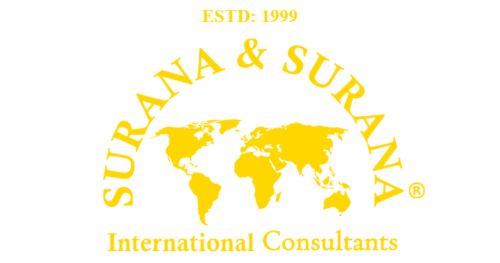The internet has massively transformed the way today’s businesses operate. In the current digital era, companies must have an online presence to build trust and customer relationships while effortlessly marketing themselves beyond borders. A company’s domain name is a critical component of its digital presence as it serves as business identifiers and promoters.
What is a Domain?
A domain is a user-friendly internet protocol (IP) address that allows users to access the product and website from any location. A domain is referred to as “Uniform Resource Locator” or “URL” which is a globally distributed internet database under the authority of “Internet Corporation for Assigned Names and Numbers” (ICANN).
“Law.org” is an illustration of a domain name. Here the first part of the domain i.e., “Law” is referred to as the “Second-Level Name”, which is picked or created by the domain holder. The last portion of the domain i.e., “.org” is referred to as the “Top-Level Domain (TLD)” and it is further divided into two;
- “Generic Top-Level Domains (gTLDs)” which is a top-level domain (TLD) category that is easily recognized by a suffix attached to a domain name[1] and;
- “Country-Code Top-Level Domains (ccTLDs)”[2] which is a top-level domain name that is used to define the domain for a particular country or a geographical area[3]. The most popular categories of top-level domains are: .com; .in; .org; .gov; .net; .biz; etc.
Purpose Of A Domain Name and Trademark
While a trademark is a graphic indicator of your company and its products in the real world, a domain name serves as your business’s digital identity. In the case of People Interactive (India) Pvt. Ltd. v. Vivek Pahwa & Ors[4], the Bombay High Court held, “it [domain name] is the Internet equivalent of a physical or terrestrial address. It directs a user to a particular part of the Web where a domain name registrant stores and displays his information, and offers his services.” When the trademarks and domain name are duly registered, they offer the following benefits:
- A registered domain name preserves and protects your web address from any unlawful use by any person or company, much like a trademark promotes and protects your brand name.
- Trademarks supports and increases the face value of your company or business, while a domain name increases the visibility and accessibility of your business globally.
- A trademark/service mark increases the prominence of the product or service in the relevant marketplace, whereas a domain name can also serve as a means of reaching your customers all over the world with your product or service.
Therefore, a well-protected domain name similar to that of a well-protected trademark is quite advantageous to a Company’s revenue and popularity.
Whether A Domain Name Can Be Registered As A Trademark?
Yes, at the national and international levels, domain names may also be registered and protected as trademarks or service marks if they meet all requirements to be properly registered and protected as trademarks and service marks.
Any specific domain name that can be used to identify and distinguish a company’s products or services from those of its rivals while simultaneously acting as a reliable online source for the aforementioned products or services can then be protected as a registered trademark if the domain name satisfies all the requirements that are often used to register trademarks and service marks.
In order to avoid confusion between businesses pertaining to the domain names and/or violation of public order or morals, a domain name must be unmistakably different from all other domain names and well-known trademark on the internet. Otherwise, the above mentioned situations could result in trademark infringement lawsuits. In relation to the above circumstance, the Supreme Court in the case of Satyam Infoway Ltd. v. Sifynet Solutions Pvt. Ltd[5] questioned whether Internet “domain names” should be considered trademarks and the Apex Court had opined that “The original role of a domain name was no doubt to provide an address for computers on the internet. But the internet has developed from a mere means of communication to a mode of carrying on commercial activity. With the increase of commercial activity on the internet, a domain name is also used as a business identifier. Therefore, the domain name not only serves as an address for internet communication but also identifies the specific internet site, and distinguishes specific businesses or services of different companies. Consequently, a domain name as an address must, of necessity, be peculiar and unique and where a domain name is used in connection with a business, the value of maintaining an exclusive identity becomes critical[6].”
Global Protection of Domain Name As A Trademark
Domain name can obtain global protection only by filing separate trademark applications in every country where it requires protection. Globally, ICANN registers and protects domain names at the global level as trademarks or service marks. This is done with the support of local, regional, and global protection provided by the various international trademark treaties of the world and the immediately relevant national trademark law.
However, no domain name can be fully protected by national or international trademark law around the globe. Thus, to achieve the goal of uniform worldwide accessibility, ICANN with the support from WIPO (World Intellectual Property Organization) has prescribed the below stated stringent measures:
- A rigorous and censorious system of registration of domain names with accredited registrars appointed by ICANN;
- An efficient and effective conflict resolution policy called the “Uniform Domain Name Disputes Resolution Policy” (UDNDR Policy) which sets out the legal framework for the resolution of disputes between a domain name registrant and a third party (i.e., a party other than the registrar) over the abusive registration and use of an Internet domain name in the generic top level domains and those country code top level domains that have adopted the UDNDR Policy on a voluntary basis[7]. Any person or business may formally launch a complaint to the qualified administration-dispute-resolution service provider designated by ICANN under Rule 4(a) pertaining to any dispute specified under the UDNDR Policy if:
- Any specified domain name is very strikingly or confusingly similar to a previously registered domain name or trademark of the complainant.[8]
- Any accused domain name has been registered, and is blatantly being used in bad faith.[9]
- There exists any certain case of trademark infringement against the complainant.[10]
Issues Pertaining to Registration Of A Domain Name As A Trademark
All domain names are registered on “first come, first served” basis. Unlike trademarks, domain name has universal application, hence the existence of two or more identical domain names can cause confusion in the mind of customers. This means that only one user can use a specific domain name and any other application will not be allowed to use the same domain name. This situation has given rise to the following problems:
- Cyber- Squatting: It is the practice of speculatively registering a well-known domain name beforehand to sell the domain name to the trademark’s actual owner with the similar or same name for a sizable amount of profit[11];
- Cyber Parasite: Similar to cyber-squatting, cyber parasites make profits by means of inappropriate use of domain name where they use similar or mistyped version of a well-known trademark to deceive the visitors and divert the traffic[12].
- Cyber Twins: The situation when both the holder of the domain name and the defiant have equal and legitimate interests over the concerned domain name[13].
Registering A Domain Name As A Trademark in India
1.Essential Conditions For Trademark Of Domain Name In India
In India, businesses can obtain trademark registration for their domain name on fulfillment of the below stated conditions:
- The domain name should be unique;
- The domain name should not be offensive;
- The business’s products and services should be identifiable and distinguishable from those of other companies in the market through their domain name;
- The domain name must not infringe on any previously registered trademarks or any marks for which a trademark registration application has been submitted to the trademark registry.
The domain name owner may submit an application for registration of trademark of domain name together with all required paperwork once all prerequisites have been met.
2.Disputes Related To Obtaining A Trademark Of Domain Name In India[14]
The following are the various disputes for which anyone can file an application for dispute resolution while obtaining a trademark of domain name in India:
- The domain name for which registration application is filed is indistinguishable or confusingly identical to already existing trademark or to mark for which a registration application is already filed;
- The owner of the trademark of domain name has no rights or interests in the registered domain name;
- The trademark of domain name is registered or is used in a malafide manner by the owner.
In circumstances where such disputes arises, any person may approach the .IN registry – an autonomous body with the primary responsibility for maintaining .IN ccTLD and ensuring its operational stability, reliability and security[15], in order to lodge a complaint. Such a complaint is to be lodged in accordance with the rules and regulations prescribed by the registry. Post filing of such a complaint, the owner of the trademark of the domain name has to go through arbitration proceedings in order to resolve the dispute.
3.Remedies Available To The Owner Of Trademark Of Domain Name In India
On obtaining the trademark for the specified domain name, the owner of the trademark is eligible to receive the same protection from any violation as compared to any other form of trademark. In the event of violation of the trademark of domain name in India, the following actions can be taken:
- Trademark Infringement: If a person is found to be violating a trademark registered under the Trademark Act, 1999, then they can be held liable under Section 29 of the Act. For this, an infringement suit of trademark is required to be filed by the owner of such trademark.
- Passing Off: In case of passing-off, the owner of the domain name can file a suit for passing off for the registration of trademark of domain name, which is pending with registrar at the trademark registry.
Conclusion
Thus, it is evident that the significance of domain names has greatly expanded in recent years, particularly in relation to online business, trade and internet communication. It can be inferred from the above discussions that registration of domain name as a trademark is a little bit ambiguous and at its early stages. In the present digital age, there is an urgent need to obtain appropriate protection for distinctive domain names, similar to that of trademarks and service marks. Even with the presence of strong trademark laws in India, there are certain complexities associated with the registration of domain name as trademarks such as cybersquatting, cyber twins, cyber parasites etc., To accurately analyze and resolve such difficulties, there is an urgent necessity to develop balanced legislation that offers a wider scope for registration of domain names as trademarks while also retaining their viability in the present scenario.
[1] Generic Top-Level Domain (gTLD), (2012), https://www.techopedia.com/definition/15673/generic-top-level-domain-gtld
[2] IP Issues Relaed to Internet Domain Names, (2013), https://www.wipo.int/sme/en/e_commerce/domain_names.html.
[3] Country Code Top-Level Domain (ccTLD), https://www.techopedia.com/definition/1323/country-code-top-level-domain-cctld
[4] People Interactive (India) Pvt. Ltd. vs. Vivek Pahwa & Ors (2016) 6 AIR Bom R 275
[5] Satyam Infoway Ltd. Vs Sifynet Solutions Pvt. Ltd., 2004 Supp(2) SCR 465.
[6] Registration of domain name as trademarks, (2020), https://indianlegalsolution.com/registration-of-domain-name-as-trademarks/#_edn4
[7] WIPO Guide to the Uniform Domain Name Dispute Resolution Policy (UDRP), https://www.wipo.int/amc/en/domains/guide/#:~:text=The%20Uniform%20Domain%20Name%20Dispute%20Resolution%20Policy%20(the%20UDRP%20Policy,generic%20top%20level%20domains%20or
[8] India: Protection Of Domain Name As A Trademark, (2014), https://www.mondaq.com/india/trademark/327272/protection-of-domain-name-as-a-trademark.
[9] id
[10] id
[11] Supra note, 6
[12] Supra note, 6
[13] Supra note, 6
[14] Trademark Of Domain Name In India, (2020), https://corpbiz.io/learning/online-trademark-of-domain-name-in-india/#What_are_the_case_laws_related_to_Trademark_of_Domain_Name_in_India
[15] Domain names registration in India updates, https://ssrana.in/ip-laws/domain-names-india/in-registry-domain-india/



